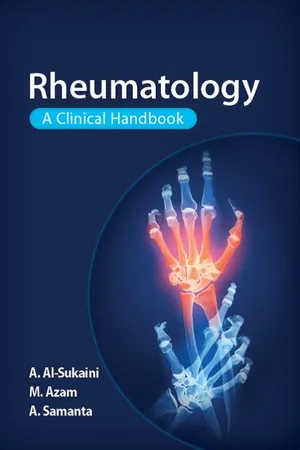![]()
Chapter 1
Introduction
What is rheumatology?
Rheumatology is a multidisciplinary branch of medicine that encompasses the investigation, diagnosis and management of patients with arthritis and other musculoskeletal conditions. This includes many disorders affecting joints, bones, muscles and soft tissues. A significant number of musculoskeletal conditions also affect other organ systems and occur as part of a systemic autoimmune disease. The main rheumatological disorders are summarized in Fig. 1.1 and will be covered in significant depth.
The rheumatology multidisciplinary team (MDT) consists of a variety of disciplines that work together with the aim of providing optimal care to sufferers via a holistic approach (Fig. 1.2). The team consists of many healthcare professionals including consultant rheumatologists, general practitioners (GPs), occupational therapists, orthopaedic surgeons, physiotherapists, psychiatrists, special nurses and many more.
Rheumatologists are specialists who deal with a wide range of rheumatic diseases. They assess overall function, including physical and mental wellbeing and level of independence. They also manage results of advanced imaging and lab tests, treatment options and the need for further assessment and management, such as referrals to other healthcare providers.
Outline of the book
Chapter 2
For each condition the following will be covered:
• Pathophysiology: the information surrounding the pathophysiology of rheumatology disorders is constantly evolving and there is still so much that remains to be understood. Up-to-date resources were used with the intention of keeping this section simple and concise and not overlooking the clinical aspects of rheumatology!
• Epidemiology and risk factors: attention has been paid to the incidence / prevalence of the rheumatology disorders so that students are aware of the very common, less common and rare disorders. Where possible, risk factors are arranged in a descending order of importance via a simple to follow table, to highlight the most important risk factors for students to learn.
• Clinical features: a variety of pedagogical features such as X-rays, photographs and illustrations have been used, as well as red flags indicated by, and mnemonics in green. Red flags or alarm systems refer to symptoms which are suggestive of significant pathology and should therefore not be missed or neglected. These devices are aimed at enabling students to have a greater understanding of the features to look out for and also as an aid to information retention.
• Diagnosis and investigations: this element is centred on the diagnostic pathway – history taking, physical examination, investigations and possible differential diagnoses. It is conveyed in an easy to follow box format. Wherever relevant, up-to-date clinical guidelines, including those from the National Institute for Health and Care Excellence (NICE), the European League Against Rheumatism (EULAR) and the American College of Rheumatology (ACR), were utilized. Chapter 4 has also been created specifically for investigations, to provide further detail of the various tests performed in rheumatology.
Fig. 1.1: An outline of the main rheumatological disorders.
• Management: this part also utilizes clinical guidelines. Flowcharts, tables and diagrams are used to convey information more effectively and render it more memorable. Chapter 5 covers the main pharmacological agents of rheumatology in further detail.
• OSCE tip / rapid diagnosis / clinical fact box: wherever applicable, extra information is provided in the form of tips for the OSCE examination, empirical diagnostic features to form a ‘rapid diagnosis’ and important clinical facts for students to be aware of.
Self-assessment questions conclude each specific condition section. These are designed for students to check that they have understood and grasped the material.
Fig. 1.2: An MDT holistic approach outline to rheumatology.
Chapter 3
This chapter consists of two important and common conditions in rheumatology which present during early life: vitamin D deficiency including both rickets and osteomalacia and juvenile idiopathic arthritis. The same longitudinal format is used as above.
Chapter 4
It may be advisable to read this before embarking on the main rheumatological conditions text (Chapter 2), as it provides a basic understanding of the three principal investigations used in rheumatology to reach a definitive diagnosis: blood tests, imaging and synovial fluid analysis.
Chapter 5
This should be used as a cross-reference with Chapter 2, in order for students to gain a deeper understanding of the way in which pharmacological agents work, as well as the side-effects and contraindications. It provides information about commonly used agents including analgesics, corticosteroids, osteoporosis agents, DMARDs and biological agents. This section also includes ‘DO’ and ‘DO NOT’ boxes so that students are aware of the essentials and common pitfalls, respectively, when prescribing pharmacological agents.
Chapter 6
This focuses on the key points of history taking and performing clinical examinations, with particular emphasis on the GALS and hand examination, so that students have a thorough structure to follow and therefore do not panic when it comes to the dreaded OSCE examinations!
In order to make the book more affordable, additional questions in the form of single best answer questions (SBAs) and extended matching questions (EMQs) have been made available online as a free resource to complement the material in the book. To access the questions and answers, go to www.scionpublishing.com/rheumatologyQandA
![]()
Chapter 2
Specific conditions
2.1 Rheumatoid arthritis
Rheumatoid arthritis (RA) is a chronic systemic inflammatory disorder which primarily affects joints that are lined with synovium. It is typically characterized by a symmetrical, occasionally deforming, peripheral polyarthritis. Because it is a systemic disease, it can also affect the whole body, including the heart, lungs and eyes.
Pathophysiology
• The actual cause of RA is not entirely understood.
• It is likely that genetically susceptible individuals are exposed to an unknown antigen resulting in self-stimulation of the immune system (autoimmunity).
• The immune response cross-reacts with the host tissu...



